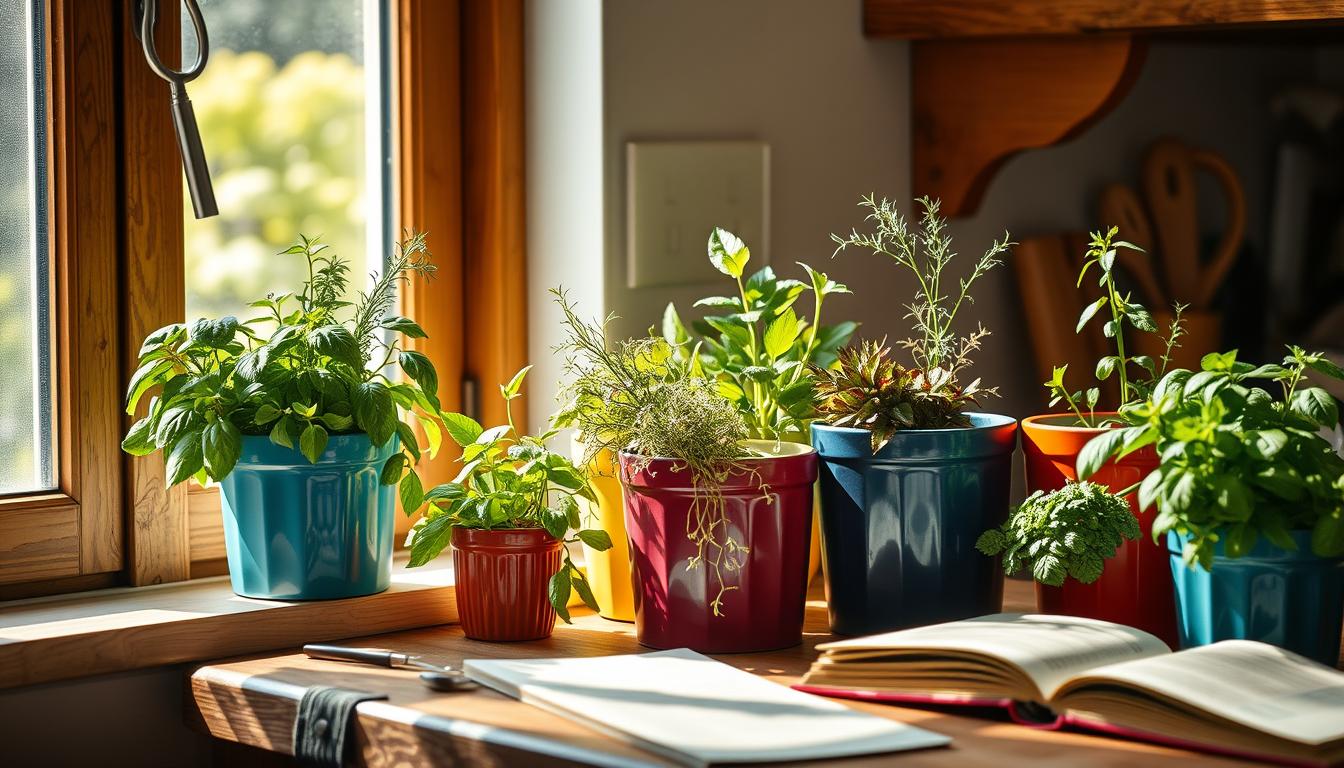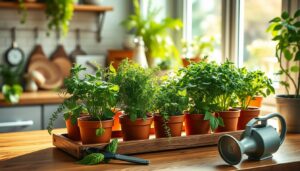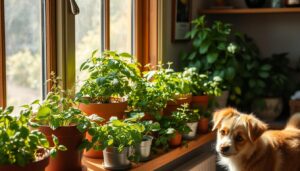Did you know the global aromatic herbs market is set to hit over $8 billion by 2027? This shows how much we all want fresh, flavorful herbs in our cooking. If you’re fed up with buying limp herbs, you’re not alone. Many people start a kitchen herb garden because they want fresh, fragrant plants easily accessible.
Even though most herbs love the outdoors, you can grow them indoors too. With the right knowledge, you can have a lush, aromatic kitchen that boosts your cooking and cleans the air. It’s all about meeting the needs of your herbs.
Key Takeaways
- Growing your own herbs at home ensures a constant supply of fresh, flavorful ingredients for your cooking.
- Cultivating an indoor kitchen herb garden can be a cost-effective and sustainable solution.
- Aromatic houseplants for the kitchen can enhance your culinary experiences and purify the air.
- Beginners should start with small plants rather than growing from seed, as that requires more time and patience.
- A timed grow light setup can provide the necessary light for herbs that prefer more than 6 hours of direct sunlight per day.
Benefits of Growing Aromatic Herbs Indoors
Growing aromatic houseplants for your kitchen brings many benefits for home cooks. You can have fresh, flavorful ingredients right at your fingertips. This makes cooking more enjoyable and exciting.
Fresh Herbs at Your Fingertips
Imagine being able to pick herbs from your indoor garden for your recipes. This means you always have what you need, right when you need it. No more trips to the store.
Cost-Effective and Sustainable
Growing your own herbs is good for your wallet and the planet. It cuts down on store-bought herb costs and reduces food waste. Plus, it’s a greener choice.
Enhancing Culinary Experiences
Using homegrown herbs in your cooking can take your dishes to the next level. The fresh flavors and scents make your meals more delicious and memorable.
“Growing your own herbs is a game-changer for any home cook. The flavor and aroma of freshly snipped herbs simply can’t be matched by store-bought varieties.”
For both seasoned chefs and new cooks, growing aromatic houseplants has clear benefits. You get convenience, save money, and improve your cooking. Having a thriving indoor herb garden is a great addition to any kitchen.
Essential Supplies for Indoor Herb Gardening
To grow a thriving indoor herb garden, you need the right indoor herb gardening supplies. You’ll need everything from herb growing containers to herb garden equipment. Having the right tools makes a big difference in growing aromatic, flavorful herbs at home.
First, pick the best indoor herb planter or herb growing containers. Choose pots with good drainage to stop waterlogging, which harms herbs. Use potting soil for herbs that drains well and is rich in nutrients.
You’ll also need a good light source. If your space lacks enough sunlight, get a grow light setup. This ensures your herbs get the light they need to grow well.
Other important tools include herb scissors for cutting, a watering can for watering, and a soil moisture meter. With these indoor herb gardening supplies and some knowledge, you’ll soon enjoy fresh, tasty herbs at home.
“Growing herbs indoors is a rewarding experience that allows you to enjoy the fresh, vibrant flavors of homegrown produce year-round.”
Selecting the Right Herbs for Indoor Growing
Not all herbs are the same when it comes to indoor gardening. Some are perfect for kitchen or living spaces, especially for beginners. Think about adding best herbs to grow indoors like basil, mint, rosemary, parsley, and chives. These are easy to care for and do well indoors.
Easy-to-Grow Herbs for Beginners
- Basil: This aromatic herb is a must-have in many kitchens. It loves indoor conditions and adds fresh flavor to your dishes.
- Mint: Mint grows quickly and has a versatile taste. It’s an easiest herbs to grow indoors and perfect for teas, cocktails, and more.
- Rosemary: Known for its unique smell and many uses, rosemary is a tough aromatic herbs for kitchen that does well indoors.
- Parsley: This herb not only tastes great but also cleans the air. It’s a wonderful culinary herbs for small spaces.
- Chives: Chives are simple to grow and bring a fresh taste to salads, soups, and other foods.
Aromatic Houseplants for the Kitchen
Also, consider adding indoor herb garden plants that are both tasty and pretty. Herbs like oregano, thyme, and sage add unique smells to your cooking. They also bring greenery and beauty to your kitchen.
“The beauty of growing aromatic herbs for kitchen indoors is that you have access to fresh, flavorful ingredients right at your fingertips, which can elevate your culinary experiences.”
Understanding Lighting Requirements
Proper lighting is key for a successful indoor herb garden. Most herbs need a lot of direct sunlight, about 6 hours a day. But, getting enough light indoors can be hard, especially in winter when it’s dark. If your home doesn’t get enough sunlight, think about getting a grow light setup. This will give your herbs the light they need to grow well all year.
Natural Sunlight vs. Grow Lights
Natural sunlight is best for herbs, but grow lights work well too. Grow lights copy the colors of sunlight, giving herbs the right light for growth. They make sure your herbs get enough light, even in dark places or during winter.
Choosing between sunlight and grow lights depends on your situation. Sunlight is cheaper, but grow lights are reliable and consistent. If your home can’t get enough sunlight for your herbs, grow lights might be the best choice to keep them healthy.
“The right lighting can make all the difference in the success of your indoor herb garden.”
Watering and Soil Considerations
For a thriving indoor herb garden, focus on watering and soil needs. Using the right herb garden soil mix and indoor herb watering methods is key. This ensures healthy growth and lots of herbs for cooking.
Herbs need well-draining soil to avoid root rot and other problems. Use a potting mix made for herbs or mix your own with well-draining soil for herbs, compost, and horticultural sand. This creates the perfect environment for your indoor herbs.
Herbs have different watering needs. Some, like mint and basil, like their soil moist. Others, like rosemary and thyme, can handle less water. Check the soil often and water when it feels dry but not too wet.
| Herb | Soil Preference | Watering Needs |
|---|---|---|
| Mint | Moist, well-draining | Consistently moist |
| Basil | Moist, well-draining | Consistently moist |
| Rosemary | Well-draining | Drought-tolerant |
| Thyme | Well-draining | Drought-tolerant |
Know what your herbs need for indoor herb watering and herb garden soil mix. This way, you can make the best conditions for them. You’ll get a lot of fresh, tasty herbs for cooking.
Pruning and Harvesting Techniques
Keeping an indoor herb garden alive means knowing how to prune and harvest. It’s key to trim your herbs often to keep them healthy and flavorful. By using the right pruning techniques, you’ll always have fresh, aromatic herbs for cooking.
Encouraging Healthy Growth
To make your herbs grow bushy and stop them from flowering, trim the top leaves or use sharp herb trimming techniques. This encourages the plant to make more leaves, giving you a bigger harvest. When you harvest herbs indoors, cut the stems just above a set of leaves. This will make your plants grow more and stay healthy.
- Regularly prune your indoor herbs to encourage bushy growth
- Use sharp herb scissors or pinch off leaves to trim the plants
- Harvest herbs by cutting stems just above a set of leaves
- Proper pruning and harvesting practices will ensure a steady supply of fresh herbs
Learning these pruning and harvesting techniques for indoor herbs will help you keep a thriving indoor herb garden. With a bit of care, you’ll have fresh, homegrown herbs ready whenever you need them.
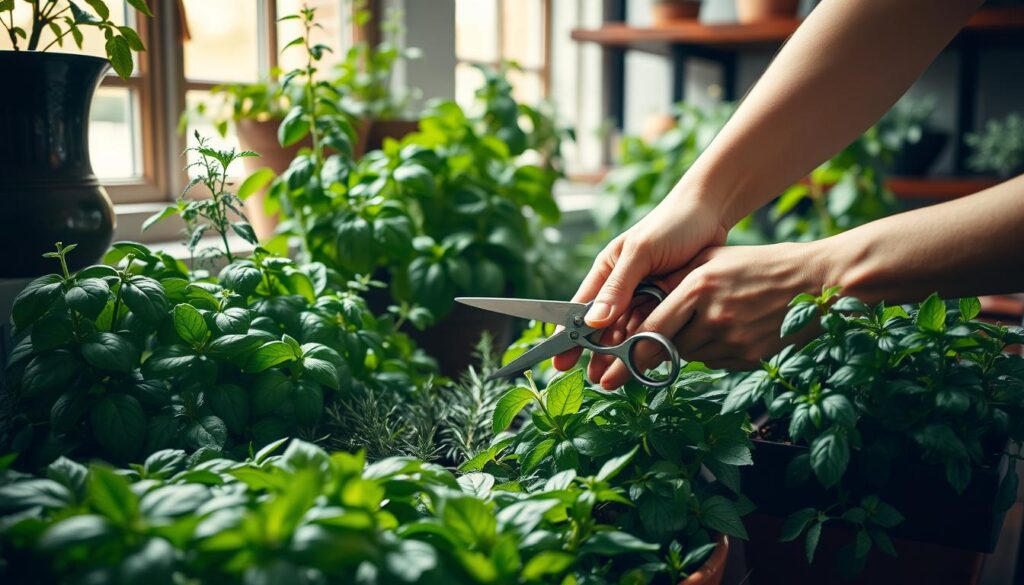
Pest and Disease Management
Keeping indoor herb plants healthy means watching out for pests and diseases. Growing herbs inside lowers the risk of many problems. But, it’s key to check on your plants often and fix any issues fast. Common pests include spider mites, aphids, and powdery mildew.
To stop and handle these issues, focus on the best growing conditions. Make sure air moves well, water plants right, and keep the area clean. These steps help keep your indoor herbs strong and healthy.
For safe pest control, think about using insecticidal soap or neem oil. These natural options can fight off pests without hurting your plants or the planet. Also, check your herbs often and remove any sick leaves or stems to stop diseases from spreading.
| Common Indoor Herb Pests | Symptoms | Organic Control Methods |
|---|---|---|
| Spider Mites | Fine webbing on leaves, stippling or discoloration | Insecticidal soap, neem oil |
| Aphids | Sticky, honeydew-like substance on leaves, stunted growth | Insecticidal soap, neem oil, introducing beneficial insects |
| Powdery Mildew | White, powdery growth on leaves and stems | Baking soda solution, neem oil, improving air circulation |
By being alert, keeping growing conditions right, and using safe pest control, you can beat indoor herb pests and diseases. This way, your herbs will do well and give you lots of fresh produce for your kitchen.
Creative Indoor Herb Garden Setups
Grow fragrant, flavorful herbs at home with a little creativity. You can make a thriving indoor herb garden. It will meet your cooking needs and add natural beauty to your kitchen.
Windowsill Gardens
Setting up a windowsill garden is easy and convenient. These gardens fit in small spaces and keep herbs close by. Choose a single herb or a mini garden for your windowsill. It’s a great way to enjoy indoor herb gardening in small areas.
Vertical Gardening Solutions
Vertical gardening is perfect for small spaces. Use tiered planters, wall-mounted gardens, or hanging baskets. These vertical herb gardens let you grow many herbs and fit well in your kitchen. Try different herb garden designs for a beautiful and useful indoor space.
“Growing your own herbs, even in a small space, can be incredibly rewarding. It’s a simple way to elevate your cooking and bring a touch of nature into your home.”
Every kitchen can have a beautiful indoor herb garden. With small space herb gardens and windowsill herb gardens, you can have fresh herbs right at your fingertips.
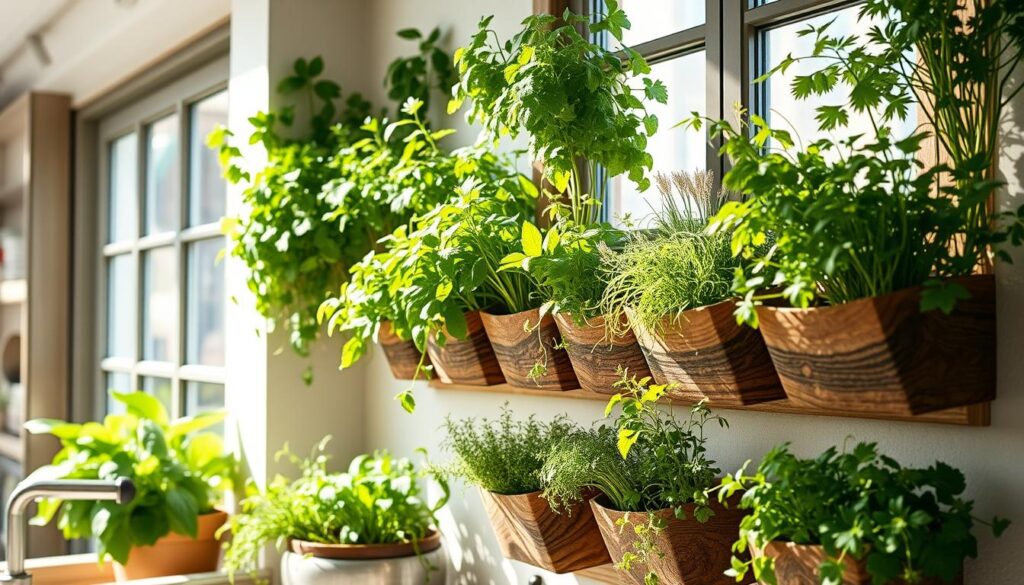
Conclusion
Growing herbs indoors is rewarding and practical. It gives you fresh, flavorful ingredients right at home. This can make your cooking better, save money, and help the planet.
Choosing the right herbs and taking good care of them lets you enjoy homegrown herbs all year. You can do this right in your kitchen.
Whether you choose a simple windowsill setup or a big vertical garden, it’s a great way to add outdoor flavors to your home. With the right tips, you can start your own indoor herb garden and explore new recipes.
Embrace the joy of growing herbs indoors. With a little effort, your kitchen can become a place of fresh, aromatic herbs. This can make every meal you cook special.
FAQ
Why should I consider growing an indoor herb garden?
What supplies do I need to start an indoor herb garden?
Which herbs are best suited for indoor growing?
How important is light for an indoor herb garden?
What are the best practices for watering and caring for indoor herbs?
How can I prevent pests and diseases in my indoor herb garden?
What are some creative ways to set up an indoor herb garden?
Source Links
- Growing Herbs 101: How to Start a Kitchen Herb Garden, Indoors or Out – https://homesteadandchill.com/grow-herbs-101-kitchen-herb-garden/
- How to Have a Thriving Kitchen Herb Garden – https://www.epicurious.com/expert-advice/how-to-have-a-thriving-kitchen-herb-garden-article
- 9 Beginner Tips for Growing Herbs Indoors: – Elevate Your Home Cooking with bon COOK – Cooking Solutions – https://boncook.com/9-beginner-tips-for-growing-herbs-indoors-experts-share-their-ideas/


